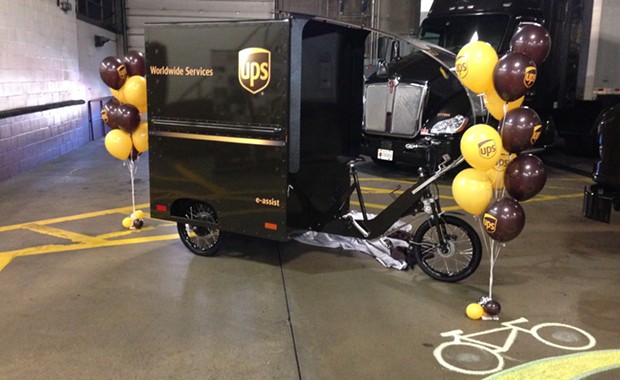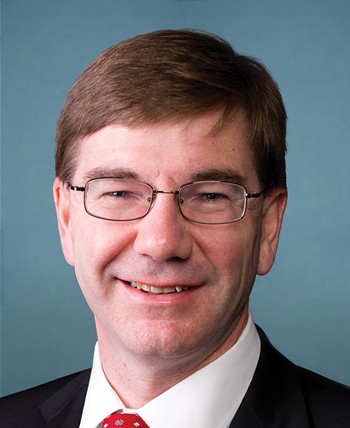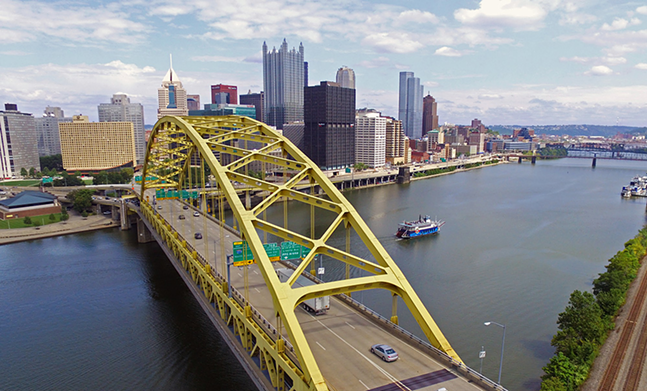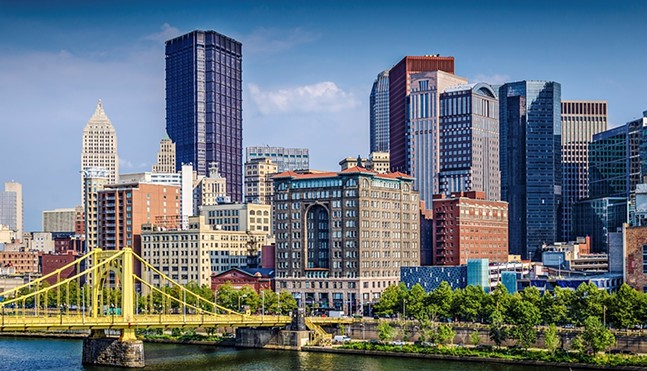Wednesday, November 8, 2017
And now delivery giant United Parcel Service (UPS), is getting in on the bike action. Starting Nov. 9, Downtown Pittsburgh will be home to UPS’s only year-round delivery route that utilizes an electric-assist bike-cart in the U.S.
The pedal-powered cart can hold up to 15-20 packages and up to 400 pounds of cargo. It comes equipped with all the lights and turn signals that cars have, but is pedal-powered Drivers are given a boost from an electric motor, that recharges as the driver pedals. (The cart is only partially powered with electricity; drivers must pedal to keep it going.)
UPS spokesperson Deanna Cain says the bike-delivery carts have had success in the crowded cities of Europe, and UPS uses the carts on special occasions in Portland, Ore. UPS first started using the “eBike” in Hamburg, Germany, in 2012. Now, UPS utilize bike delivery in 12 European cities. Cain says Pittsburgh is the perfect place to start the company's first U.S. year-round route.
“It’s good for downtown areas with narrow streets like Pittsburgh,” says Cain of the electric-assist bike-cart. “It has zero emissions and no fuel consumption. As more cities move towards sustainability, we want to follow that model.”
Karina Ricks, Pittsburgh’s director of mobility and infrastructure, is “thrilled,” that UPS will be utilizing bike-powered delivery in Downtown.
“This aligns with our climate-change goals, we like progressive solutions like these,” says Ricks. “This will help with traffic congestion, given our narrow streets Downtown.”
UPS’s Three Rivers division manager Nick Passaro says the new bike cart will reduce carbon emissions, noise and congestion Downtown. “We want the world to view Pittsburgh as a progressive place, that cares about the environment.”
Tags: United Parcel Service , Pittsburgh , bike , bike-lanes , Karina Ricks , Nick Passaro , sustainability , environment , Downtown , eBike , Image
Friday, October 27, 2017
And while this appears to be just another Trump action negating a rule created during President Barack Obama’s tenure, this roll-back was actually proposed and sponsored by Pittsburgh-area U.S. Rep. Keith Rothfus (R-Sewickley). In an Oct. 24 statement, Rothfus said of the Obama-era proposed rule, “Plain and simple, this rule will harm consumers and line the pockets of trial lawyers—something that contradicts the very mission of the Consumer Financial Protection Bureau. It is yet another example of an out-of-touch Washington mandate handed down from this unconstitutional and widely unaccountable agency.”
The Consumer Financial Protection Bureau (CFPB) was created in 2010 to shield consumers from unscrupulous practices of financial institutions and has been championed by tough-on-Wall-Street politicians like U.S. Sen. Elizabeth Warren (D-Massachusetts). And while Rothfus, who represents Pennsylvania's 12th U.S. Congressional District, claims that rolling back the rule will help consumers, the change comes at an odd time, considering the headlines made by Wells Fargo bank, and its fake-account scandal, and the security breach at credit-monitoring firm Equifax.
The Atlantic Monthly points out on Oct. 25 that consumers could suffer and companies like Wells Fargo and Equifax could actually benefit from the Rothfus’ rule change. It writes: “The nullification of the CFPB’s rule means that people who suffered financial harm or identity theft as a result of either of these large companies’ lapses may not have the right to take them to court.”
The U.S. Department of the Treasury issued a 17-page report before the vote, criticizing the CFPB rule. The Treasury report said the rule costs businesses “extraordinary” fees without providing many benefit to consumers. (It should be noted that the Treasury Secretary is Steven Mnuchin, the former executive vice president of financial giant Goldman Sachs, a company criticized for contributing to the 2008 financial crisis due to shoddy mortgage-lending practices.)
Also of interest is while Rothfus claims that the CFPB rule was an “out-of-touch” mandate, most Americans actually support the work of the CFPB. According to five years of surveys conducted by the Americans for Financial Reform and the Center for Responsible Lending, 74 percent of voters support the CFPB, with 85 percent of Democrats backing the organization and 66 percent of Republicans supporting it.
Even a 2016 Morning Consult poll of Trump voters found that a plurality of 41 percent of respondents believe the Trump administration shouldn’t alter the CFPB.
Rothfus received a lot of negative reactions on Facebook from constituents after he announced his bill cleared the U.S. Senate. The bill easily cleared the U.S. House mostly along party lines, but received a 50-50 tie in the U.S. Senate. Vice President Mike Pence cast the tie-breaking vote.
Earl Lynch, who is listed as a constituent on Facebook, commented on Rothfus’ page: “You could have given the consumer the freedom to choose between litigation and mediation when a conflict arose. But you decided to protect the big boys and screw me. You’re not a Republican. You’re a Corporationist.”
Another constituent, Amanda Surratt, wrote, “Thanks for making it impossible for regular folks to stand up to ultra rich & powerful corporations.”
Some constituents even insinuated that Rothfus’ push to change the CFPB is tied to campaign donations he receives from financial institutions and banks. It’s impossible to determine if donations influence Rothfus’ actions, but the congressman has received significant backing from big banks and other financial organizations.
Dollar Bank, the Pittsburgh region’s largest community bank, has given Rothfus $13,700 since 2013, according to campaign-finance-tracking website followthemoney.org and 2017 campaign-finance disclosures. Since 2013, Goldman Sachs has given $10,500 to Rothfus' campaigns, and Equifax even gave $2,000 to Rothfus' campaign this year.
Since 2009, Rothfus’ campaigns have received more than $140,000 from commercial banks. Overall, the finance, insurance and real-estate industries have been among the biggest contributors to Rothfus’ campaigns, funneling about $865,000 to him over the years.
A request for comment from Rothfus' office went unanswered as of press time.
Rothfus currently has four Democratic opponents challenging him for his seat: Aaron Anthony, of Shaler; Tom Prigg, of McCandless; John Stolz, of Shaler; and Beth Tarasi, of Sewickley. Rothfus will face re-election in 2018.
Tags: Keith Rothfus , Donald Trump , Steven Mnuchin , Consumer Financial Protection Bureau , House Joint Resolution 111 , Wells Fargo , Equifax , Americans for Financial Reform , Center for Responsible Lending , Morning Consult , Dollar Bank , PolitiCrap , Image
Friday, September 8, 2017
But economic factors and development realities in Pittsburgh indicate the region is far from Amazon’s sweet spot. Amazon’s list of preferences is intimidating. The tech company is first looking for a 500,000-square foot existing building that is close to a population center of more than 1 million people and near major highways. This will already be hard to find in Pittsburgh, as the city’s biggest building, the U.S. Steel Tower, only currently has about 300,000 square feet available.
With Amazon’s most preferred option most likely off the list, the second option would be a 100-acre pad-ready development site. Pittsburgh is filled with brownfields, old industrial sites the require clean up, and pad-ready sites are hard to come by. Especially ones that are “close to major arterial roads to provide optimal access,” as Amazon is demanding. Some have indicated the old Civic Arena site as a possibility, but that site is only 28 acres.
Additionally, the 500,000-square-foot site would just be the first part of Amazon’s development. Eventually, the company is looking to build a headquarters similar to its 8-million-square-foot Seattle headquarters.
The larger Almono site in Hazelwood has also been floated around as an option, but this site, while already in redevelopment, comes up short in Amazon’s requirement of having “direct access to rail, train, subway/metro, bus routes.” Currently, the Almono site does not connect to light-rail or even to one of the city’s three busways. Only three buses serve part or all of Almono — the 56, 57 and 58 — and they only arrive about every 20-30 minutes; hardly a vibrant public-transit hub. Not to mention the vision of Almono site is to house multiple companies, not one large one.
Chris Briem, an economist at University of Pittsburgh’s Center for Social and Urban Research, says this is out of scope for the Pittsburgh area. “Is there is site for them?” asks Briem. “Eight million square feet, I mean, that is like three U.S. Steel Towers. … Space has always been a terrible challenge for Pittsburgh.”
Besides the lack space available, Amazon is also looking for an extensive incentive package of tax-breaks, relocation grants, fee reductions and site preparation. Pittsburgh and Allegheny County can only offer limited incentives, like Tax Increment Financing and Local Economic Revitalization Tax Act District distinction, which provide city and county tax breaks for a few years.
However, most regions can offer these, so Briem says further incentives will have to come from the state. Briem adds it will be difficult to convince the state to allocate money for incentives when it is currently struggling to pass a budget. Also, Briem points out that Pennsylvania has a history of offering large state subsidies to companies and getting burned.
Pennsylvania gave $70 million in incentives to Volkswagen to build a plant in Westmoreland County. It opened in 1978 and by 1988, it was closed. But, Pittsburgh does have advantages other places can’t offer. The region has some of the lowest housing costs in the country, and Pittsburgh is emerging as a world leader in robotics and artificial-intelligent technologies.
However, Pittsburgh probably doesn't have a large enough workforce, filled with highly-educated workers, to satisfy Amazon. The company is requesting filling an estimated 50,000 positions. Bloomberg columnist Conor Sen paints grim prospects for Pittsburgh. “Consider a place like Pittsburgh,” Sen wrote in a Sept. 7 Bloomberg article. “Its metro area is 2.35 million people, and its labor force is 1.2 million. But the size of its labor force hasn't grown in 25 years. Even with the talent [Pittsburgh’s] well-respected universities produce, [why] is Amazon, a company that thinks of growth in terms of decades, going to locate a headquarters in a place where it might have to hire over 4 percent of the metro area's labor force with uncertainty over whether that labor force will ever grow?”
And, unfortunately, the final nail in Pittsburgh’s Amazon coffin might be the Pittsburgh International Airport. The airport still lacks the international access that a hub like Atlanta, Chicago and even Philadelphia can offer. It also lacks a direct flight to Seattle, home of Amazon.
Well-known urban planning expert Richard Florida corresponded with Pittsburgh City Paper via Twitter about Pittsburgh's chances at getting Amazon. Florida, a former Carnegie Mellon University professor and Pittsburgh fanboy, indicated our airport may not be up to task.
“I adore Pittsburgh, but I put it more of a sleeper category along with, say, Nashville,” wrote Florida in a tweet to CP. “Great assets but lacking in global airport access.”
Politicians like Peduto and Fitzgerald shouldn’t be faulted for trying, as Amazon moving to Pittsburgh would be a game-changer and would potentially turn around Pittsburgh’s shrinking population problem. And Florida hinted in a tweet that Amazon should consider cities that might struggle to offer incentives like Pittsburgh or Detroit, because of the good the company could do.
“On the Amazon HQII decision: they should take the highroad, turn down any form of incentives & create a model of inclusive prosperity,” tweeted Florida on Sept. 7.
But in a world where large companies like Amazon control so much influence, Florida indicated that those companies are likely to pass over Pittsburgh for cities that makes more sense economically, and those tend to be regions that are already thriving.
“Exactly right. [Amazon] will go to established places that are already talent magnets,” tweeted Florida on Sept. 7. “The world is getting spikier.”
Tags: Pittsburgh , Allegheny County , Bill Peduto , Rich Fitzgeral , Chris Briem , Conor Sen , Bloomberg , Amazon , Rich Florida , Seattle , Atlanta , Philadelphia , Pittsburgh International Airport , Almono , U.S. Steel Tower , Image
Thursday, May 11, 2017
Tags: Pittsburgh metro area , Brookings Institution , Image
Thursday, August 4, 2016
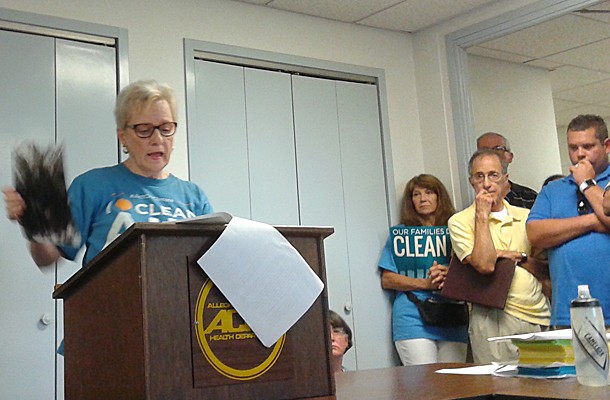
On Monday night, about 100 people crammed into a small, stuffy room at the Allegheny County Health Department's air-quality offices, in Lawrenceville, to testify on a proposed permit for the Cheswick coal-fired power plant, which sits along the Allegheny River in Springdale.
Plant employees and union members pleaded with the health department to recognize that the permit would hurt the power plant economically, while residents living near or upwind of the facility urged the department to recognize pollution's cost on human health.
"We do not oppose reasonable regulations," said Kenn Bradley, a worker with the International Brotherhood of Electrical Workers Local 29, in his public testimony. "We all want clean air, but the plant workers are very concerned that the proposed Title V permit from the county would increase operating costs and ... puts the Cheswick power station at an economic disadvantage with respect to taxpayer-subsidized renewables and other power plants outside of the county."
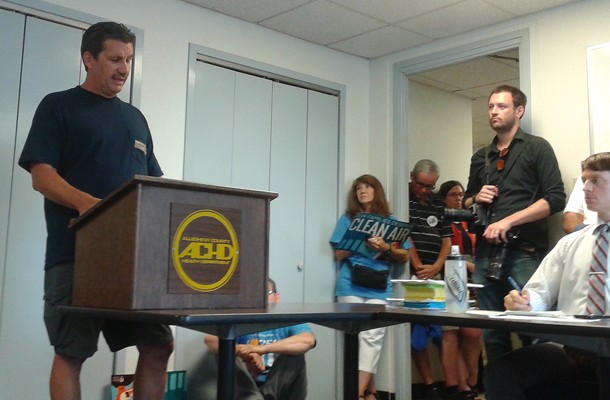
The proposed permit tightens the amount of sulfur dioxide (SO2), nitrogen oxide (NOX), particulate matter smaller than 2.5 microns (PM2.5) and sulfuric-acid mist that the plant's owner, GenOn, can emit. Comparing the plant’s former permit to the new draft, health-department deputy director Jim Thompson says the amount of allowable SO2 would decrease by 59 percent; allowable NOX by 48 percent; PM2.5 by 25 percent; and sulfuric-acid mist by 80 percent. The permit would also require the plant to run its pollution-reducing equipment most of the time.
The plant has not been running at full capacity, and its emissions levels have been below its current allowable limits. But Thompson says that if the plant ran at the same rate as it did in 2014, NOX emissions should be reduced by about 70 percent.
According to the U.S. Environmental Protection Agency, SO2, sulfuric-acid mist and NOX released into the atmosphere cause acid rain and form ozone (which forms smog). Exposure to SO2 can also affect the respiratory system, causing asthmatic symptoms. Also, the EPA says, “numerous scientific studies connect particle pollution exposure to a variety of health issues” including reduced lung function, asthma attacks, heart attacks and premature death in those with lung or heart disease. These pollutants can travel in the wind for long distances, affecting surrounding areas, even in other states.
That's why several residents testified in support of the new permit.
"How many of us need clean air to breathe, to live? We have a responsibility. We are showing our responsibility and saying, 'Please do your best for us,'" Dianne Peterson, who lives roughly ten miles from the plant, said to health-department staff present at the hearing. "Because when you get sick, what wouldn’t you do to get your health back? It’s your kid, your body, your spouse, your asthma, your cancer. It’s all of our responsibilities, and we’re handing it to you and saying, ‘Please take it to the most stringent level you can to protect all of us.’”
A resident who lives across the street from the plant, Marti Blake, waved around photographs of black dust that builds up on her patio. "I'm consistently cleaning coal particles."
While several comments took an emotional tone about the economy and health, local air-quality watchdog Group Against Smog and Pollution, which has previously worked on regulations for Cheswick, read a statement — and submitted written comments — regarding whether the health department is consistently following the EPA's SO2-measurement rules.
"The Rule expressly requires that 'the air agency [emphasis in original] shall conduct the modeling analysis' if it chooses to use air dispersion modeling to characterize peak 1-hour concentrations of SO2 in areas effected by emissions from a source that is subject to the Rule," GASP executive director Rachel Filippini read from her written statement. (CP obtained a copy after the hearing.) "Section V.A.1.u [of the permit] would violate the Rule by allowing the Plant’s operator to conduct the air dispersion modeling. To comply ... ACHD, the air agency with jurisdiction over the Plant, must be the one to conduct air dispersion modeling pursuant to the Rule."
In its written statement, emailed to CP after the hearing, power company NRG — which recently acquired GenOn — contends that its already doing environmentally responsible work because it installed pollution-reducing equipment.
"GenOn, now a subsidiary of NRG, has spent more than $400 million on emissions control equipment at the Cheswick plant since 2003, and has dramatically improved the plant’s environmental footprint," said a written statement emailed by David Gaier, NRG spokesperson. "The plant is, and has been in compliance with all applicable environmental laws and regulations including all statewide standards established by PA DEP. We look forward to continue working with the ACHD to arrive at a permit that is fair, environmentally responsible, and keeps the station on an equal footing with other generators across the state."
According to the health department's press officer, Melissa Wade, the public record of the hearing will be available on the department's website within a few days.
Tags: Cheswick Generating Station , Allegheny County Health Department , Image
Tuesday, July 12, 2016
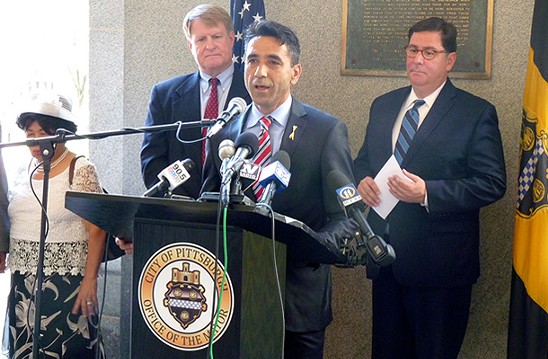
That discrepancy is why public officials like Pittsburgh Mayor Bill Peduto and Allegheny County Executive Rich Fitzgerald are praising the contributions immigrants are bringing to the region.
“It is not just the welcoming heart of the city, it is the economic growth of the region that is the biggest beneficiary,” Peduto said at a press conference on June 12. “A resurgence in our economy that is being fueled by people coming from other countries.”
Peduto says that immigrants in Allegheny County contributed $217 million in state and local taxes in 2014 and had a spending power of $1.8 billion that year. (This makes up 6.3 percent of the county’s spending power, which is also above the percentage of the county’s immigrant population.)
“It’s great that we have been able to capture some of the data that a lot of us knew empirically about how important the immigrant population has been over the last few years, has been to our economy and quality of life,” Fitzgerald said at the press conference Downtown.
Fitzgerald said in a five-year period, starting in 2009, property values nationally were declining, but in Allegheny County, the values were increasing, with a big boost from immigrants. He also pointed to the study for showing that while the Pittsburgh region’s population slightly declined since 2009, the foreign-born population increased by 8 percent.
“When you look at the contribution that the immigrant population has helped in stemming population decline, improving property values, that contribution that they have meant to our economy is tremendous,” said Fitzgerald.
Peduto said that immigrants are “building a new economy” in the city. Their rates of entrepreneurship are higher than U.S.-born residents in Allegheny County, and are also higher than the national average.
The study also shows that Pittsburgh immigrants have higher educational rates than average, but Betty Cruz of Peduto’s Welcoming Pittsburgh initiative tells City Paper that low-income residents were contributing to the growth too. She says the $217 million in taxes were contributed from “across the board” and not just from wealthier immigrants.
Cruz says immigrants from all backgrounds have contributed positively to “main street” economies like Asian immigrants in Squirrel Hill and Latinos in Beechview.
Tags: Bill Peduto , Rich Fitzgerald , immigrant , Welcoming Pittsburgh , entrepreneurship , undocumented immigrant , U.S. , Image
Thursday, December 17, 2015
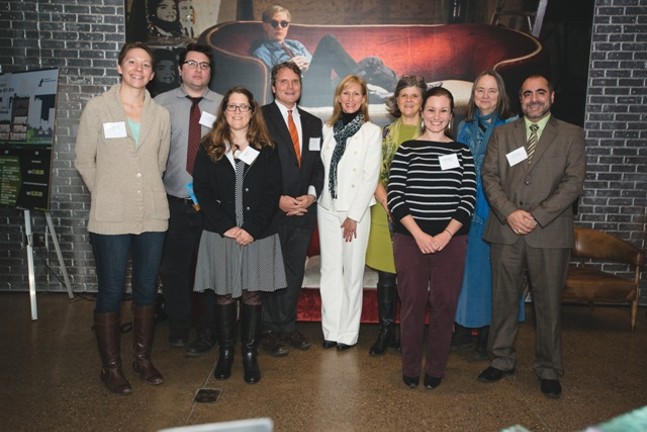
About 50 area employers participated in Sustainable Pittsburgh’s third “friendly competition” to see who could most reduce their use of energy and other resources over the past year.
Competitors – including businesses, nonprofits, universities and government entities ranging from tiny to huge – earned points for everything from switching to more energy-efficient lightbulbs to installing solar panels.
Winners were announced Dec. 2. Perhaps most impressive was the Top Legacy Performer award-winner — Conservation Consultants Inc. The South Side-based nonprofit is using 66 percent less energy than it did during the Challenge’s baseline year of 2010-11. (Even back then, this outfit, whose job is telling people how to save energy, was already using much less than the average for a building its size.)
Competitors also accumulated points for cutting water use, reducing landfilled waste and getting employees to use less environmentally harmful means of transportation.
Winning the category of Micro Business was Pashek Associates. The Small Business winner was evolveEA; the Medium Business winner was The Mall at Robinson; and the Large Business winner was Highmark.
Nonprofit winners included the Group Against Smog and Pollution (micro), GTECH (small) and Carnegie Museums of Pittsburgh (medium). The Carnegie also won the Top Energy Saver award by reducing energy usage in its facilities by 22 percent over the course of the year, and the Top Water Saver, with a reduction of 17 percent.
Pitt won the University category. And among municipalities, the winners Allegheny County (large) and Monaca Borough (small). Allegheny County was also the top waste reducer, cutting the waste it landfilled by a remakable 62 percent (via producing less waste to begin with, and recycling or composting more of what was left).
But here’s an editorial word of caution: The Green Workplace Challenge is swell, and to whatever extent it saves resources and increases awareness it’s all to the good. If everyone could be like CCI, and cut their already miserly energy use by two-thirds, we’d be in much better shape.
However, the Challenge is a voluntary program whose goal is engagement, rather than achieving a level of resource use that might actually make a particular business (let alone our society) anything close to environmentally sustainable.
Consider this figure from the Sustainable Pittsburgh press release on the Challenge: “[P]articipants saved over 2,865 metric tons of carbon dioxide equivalent, which translates to roughly 73 airline flights of 500 miles: roughly 2/3 of day worth of all flights leaving Pittsburgh International Airport on a typical day.”
That means that 50 local employers – including such massive entities as Pitt, Highmark and Allegheny County government – labored in earnest for an entire year and didn’t even offset one full day of flights at single medium-sized airport.
In the week after the much-discussed Paris climate talks, it makes you realize how far a society that practices fossil-fueled jet travel has to go to address environmental crises like climate change.
So while we celebrate these results, keep in mind that the Challenge is no substitute for what we really need: Systemic change (like, say, a federal carbon tax) that will move everybody (not just volunteers) as far as possible and as quickly as possible toward living within our environmental means.
Tags: Green Workplace Challenge , Sustainable Pittsburgh , environment , energy , Image


